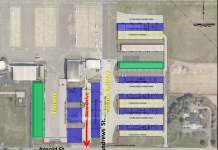
Cummins Inc. Corporate Office Building in downtown Columbus is shown in this file photo from April. Republic file photo
Cummins Inc. beat Wall Street sales expectations in the third quarter but missed profit forecasts and lowered the company’s full-year revenue projection due to global supply chain challenges and associated costs.
The Columbus-based company reported Tuesday third-quarter revenues of $5.97 billion, a 17% increase from the same quarter last year and above the Bloomberg estimate of about $5.86 billion.
Sales in North America increased 13% and international revenues increased 22% driven by strong demand across most global markets, the company said.
Net income during the July-to-September quarter was $534 million, or $3.69 per share, up from $3.36 per share during the same quarter in 2020 but lower than the Wall Street consensus by about 20 cents per share.
Looking ahead, Cummins now expects its full-year revenue to be up about 20% from last year, down from prior guidance of 20% to 24% despite strong customer demand.
Cummins officials said the company revised its outlook due to continued global supply chain challenges — including the global semiconductor shortage — which have impacted the automotive industry’s ability to meet demand and has resulted in higher freight, labor and logistics expenses and rising material costs.
“The one thing that everybody is still worried about in our industry is semiconductors,” Cummins Chairman and CEO Tom Linebarger said Tuesday during an earnings conference call. “It’s not that things haven’t improved some because they have. But it’s marginal improvement. It’s still a really tight supply chain. So there’s a lot of issues across the supply chain, labor shortages, freight, etc., but semiconductors look like they have a longer-term capacity issue. And I’d also say the freight side of things just seems like it’s not quite getting better yet when you look at where containers are and what ports look like.”
Segment performances:
Engine: Sales of $2.6 billion were up 22% compared to the same quarter last year. On-highway revenues rose 22% driven by strong demand in the North American truck market.
Off-highway revenues were up 21% due to strong demand in North American, Asian Pacific and European construction markets. Sales increased 23% in North America and 19% in international markets.
Distribution: Sales of $2 billion represented a 14% increase over the July-to-September quarter last year. Revenues in North America were up 10% and international sales increased 21%. Demand increased across the power generation and engine markets in addition to parts and service compared to last year.
Components: Sales were $1.8 billion, up 16% compared to the same quarter last year. Revenues in North America increased 21% and international sales rose 11%.
Power Systems: Sales of $1.2 billion were up 19% from the third quarter 2020. Power generation revenues increased 10% due to growth in recreational vehicle and datacenter markets, while industrial revenues increased 33% driven by stronger demand in mining markets.
New Power: Sales of $23 million represented a 28% compared to the same period last year. Revenues increased due to greater demand in transit and school bus markets, as well as the shipments of fuel cell systems to the rail market. Electrolyzer revenue decreased due to the timing of commissioning of projects.
Supply chain woes
Cummins’ third-quarter results came as the global auto industry is wrestling with a range of supply chain bottlenecks — including a shortage in semiconductors that are widely used in automotive electronics.
The shortage has been rippling through various markets since summer 2020, as demand for their use in everything from game consoles to tablets to webcams has exceeded the ability of chip makers to quickly increase production capacity, The Associated Press reported.
It has delayed the release of popular products such as the iPhone and made it hard to finish building vehicles that use chips for computers that control a range of things, including gas pedals, transmissions and touch screens, according to wire reports.
Last week, Ford and General Motors said the global chip shortage cut into their third-quarter profits, according to wire reports. Volkswagen also lowered its forecast for deliveries to customers last week and reported a decrease in operating profits for the third quarter as the global shortage of semiconductors disproportionately hit the company’s business in China.
PACCAR Inc., which Cummins said in its 2020 annual report was its largest customer, accounting for 15% of consolidated net sales last year, also has been impacted by the chip shortage.
Last month, the company, which makes medium- and heavy-duty trucks under the brands Kenworth, Peterbilt and DAF, said the shortage had reduced its truck deliveries in the third quarter by about 7,000 vehicles, compared to the quarter last year.
Cummins, for its part, has been working through some supply-chain challenges, including a global shortage of semiconductors and other components, with company officials acknowledging in June some “sporadic impact on production.”
Cummins warned investors and analysts in its first quarter report this year that the shortages could “lead to manufacturing delays, increased costs and the loss of sales.”
In June, Jack Kienzler, Cummins executive director of investor relations, said during a virtual conference that the company has seen “increasing overtime and lack of productivity at some of our plants as you’re waiting for certain parts that you need for assembly.”
However, overall, production remained “strong,” company spokesman Jon Mills told The Republic in June.
On Tuesday, Linebarger said the United States needs domestic or closer-to-shore semiconductor manufacturers that cater more to the auto industry, or at least “manufacturers who think the automotive industry is more critical to their success.”
The consumer-electronics market generates far more revenue for chip makers than the auto industry, according to wire reports.
“The thing we really need in the U.S., of course, is … domestic semiconductor production that’s targeted at the automotive industry,” Linebarger said. “I don’t mean to be pie-in-the-sky about it, but strategically, it’s kind of a nightmare that all our semiconductor wafers are coming from pretty much one factory or one set of factories in Taiwan, and we’re a very small part of that company’s output. That’s not the ideal situation for a supply chain.”
“Right now, most trucks and buses are adding a significant portion of electronics each revolution,” Linebarger added. “Each time that their new product revs come out, they add 30% more chips or sensors or something, and that’s not the way the capacity of semiconductors is moving.”
Analysts react
Local analysts said the global supply chain constraints are not unique to Cummins, viewing them more as a “blip on the screen” for the company than a sign that downturn is on the horizon.
“It’s not anything people should be alarmed by,” said Roger Lee, a senior research analyst with Columbus-based Kirr, Marbach and Co. “It’s a lot of the things that we are seeing across the whole market. Everyone is seeing supply chain problems. Everyone is seeing costs, inflation. Everyone’s sort of seeing the same.”
Craig Kessler, president and chief investment officer with Columbus-based Kessler Investment Group, said he expects that Cummins will continue to deal with supply chain constraints “for the next couple of quarters” but believes the company will manage through the challenges well.
“It wasn’t a sales issue,” Kessler said. “I think they would have had a lot more sales if it weren’t for the supply chain issues. So once the supply chain comes online, their sales are going to go up. And once they get their arms wrapped around the inflation issues, they’re going to bring profit margins back in line.”
“I don’t think there’s anything that Columbus, Indiana should be concerned with about the health of the company,” Kessler added. “…This is more of a blip on the screen than a signal that a downturn is coming.”




